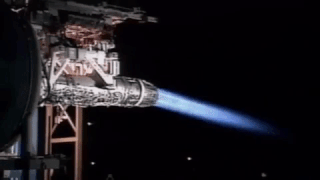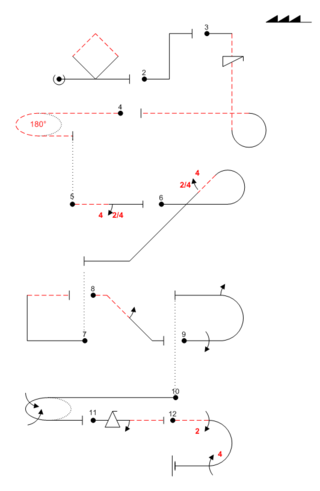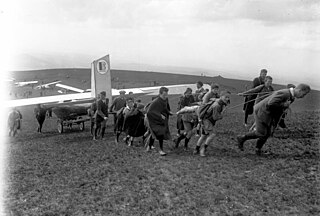
An aileron is a hinged flight control surface usually forming part of the trailing edge of each wing of a fixed-wing aircraft. Ailerons are used in pairs to control the aircraft in roll, which normally results in a change in flight path due to the tilting of the lift vector. Movement around this axis is called 'rolling' or 'banking'.
Lift-induced drag, induced drag, vortex drag, or sometimes drag due to lift, in aerodynamics,, is an aerodynamic drag force that occurs whenever a moving object redirects the airflow coming at it. This drag force occurs in airplanes due to wings or a lifting body redirecting air to cause lift and also in cars with airfoil wings that redirect air to cause a downforce. It is symbolized as , and the lift-induced drag coefficient as .

Aircraft flight control surfaces are aerodynamic devices allowing a pilot to adjust and control the aircraft's flight attitude.

Thrust vectoring, also known as thrust vector control (TVC), is the ability of an aircraft, rocket or other vehicle to manipulate the direction of the thrust from its engine(s) or motor(s) to control the attitude or angular velocity of the vehicle.

In aeronautics, air brakes or speed brakes are a type of flight control surface used on an aircraft to increase the drag on the aircraft. When extended into the airstream, air brakes cause an increase in the drag on the aircraft. When not in use, they conform to the local streamlined profile of the aircraft in order to help minimize drag.

A vertical stabilizer or tail fin is the static part of the vertical tail of an aircraft. The term is commonly applied to the assembly of both this fixed surface and one or more movable rudders hinged to it. Their role is to provide control, stability and trim in yaw. It is part of the aircraft empennage, specifically of its stabilizers.
Adverse yaw is the natural and undesirable tendency for an aircraft to yaw in the opposite direction of a roll. It is caused by the difference in lift and drag of each wing. The effect can be greatly minimized with ailerons deliberately designed to create drag when deflected upward and/or mechanisms which automatically apply some amount of coordinated rudder. As the major causes of adverse yaw vary with lift, any fixed-ratio mechanism will fail to fully solve the problem across all flight conditions and thus any manually operated aircraft will require some amount of rudder input from the pilot in order to maintain coordinated flight.

Balanced rudders are used by both ships and aircraft. Both may indicate a portion of the rudder surface ahead of the hinge, placed to lower the control loads needed to turn the rudder. For aircraft the method can also be applied to elevators and ailerons; all three aircraft control surfaces may also be mass balanced, chiefly to avoid aerodynamic flutter.

P-factor, also known as asymmetric blade effect and asymmetric disc effect, is an aerodynamic phenomenon experienced by a moving propeller, wherein the propeller's center of thrust moves off-center when the aircraft is at a high angle of attack. This shift in the location of the center of thrust will exert a yawing moment on the aircraft, causing it to yaw slightly to one side. A rudder input is required to counteract the yawing tendency.

Radio-controlled aerobatics is the practice of flying radio-controlled aircraft in maneuvers involving aircraft attitudes that are not used in normal flight.

KLM Cityhopper Flight 433 was a Saab 340B, registered as PH-KSH, which crashed during an emergency landing on 4 April 1994 and killing 3 occupants, including the captain. Flight 433 was a routine scheduled flight from Amsterdam, the Netherlands, to Cardiff, Wales. The accident was caused by inadequate pilot training and faulty failure sensor, leading to loss of control during go-around.
During the 1990s, a series of issues affecting the rudder of Boeing 737 passenger aircraft resulted in multiple incidents. In two separate accidents, pilots lost control of their aircraft due to a sudden and unexpected rudder movement, and the resulting crashes killed everyone on board, 157 people in total. Similar rudder issues led to a temporary loss of control on at least one other Boeing 737 flight before the cause of the problem was ultimately identified.

USAir Flight 427 was a scheduled flight from Chicago's O'Hare International Airport to Palm Beach International Airport, Florida, with a stopover at Pittsburgh International Airport. On Thursday, September 8, 1994, the Boeing 737 flying this route crashed in Hopewell Township, Pennsylvania while approaching Runway 28R at Pittsburgh, which was USAir's largest hub at the time.

A flight control mode or flight control law is a computer software algorithm that transforms the movement of the yoke or joystick, made by an aircraft pilot, into movements of the aircraft control surfaces. The control surface movements depend on which of several modes the flight computer is in. In aircraft in which the flight control system is fly-by-wire, the movements the pilot makes to the yoke or joystick in the cockpit, to control the flight, are converted to electronic signals, which are transmitted to the flight control computers that determine how to move each control surface to provide the aircraft movement the pilot ordered.
3D Aerobatics or 3D flying is a form of flying using flying aircraft to perform specific aerial maneuvers. They are usually performed when the aircraft had been intentionally placed in a stalled position for purposes of entertainment or display. They are also often referred to as post-stall maneuvers, as they occur after aerodynamic stall has occurred and standard control surface deflections, as used in flight, are not effective.

The Akaflieg Darmstadt D-9 Konsul, often shortened to Darmstadt D-9 Konsul, was a high performance, single seat, cantilever monoplane sailplane, designed and built by a German University student group in 1923 for hill soaring.

Northwest Airlines Flight 85 was a scheduled international passenger flight from Detroit Metropolitan Wayne County Airport in the United States to Narita International Airport in Japan. On October 9, 2002, while over the Bering Sea, the Boeing 747-400 experienced a lower rudder hardover event, which occurs when an aircraft's rudder deflects to its travel limit without crew input. The 747's hardover gave full left lower rudder, requiring the pilots to use full right upper rudder and right aileron to maintain attitude and course.

Aeroflot Flight 1802 was a commercial flight from Vinnytsia to Moscow that crashed after the rudder deflected sharply and the propellers feathered on 15 May 1976. All 52 passengers and crew aboard the aircraft perished in the crash.
A rudder travel limiter, or rudder limiter, is a controlling device in an aircraft used to mechanically limit the maximum rudder deflection.

Aeroflot Flight 3630 was a regularly scheduled passenger flight operated by Aeroflot from Mineralnye Vody Airport to Vilnius Airport with a stop over at Rostov-on-Don Airport. On 2 September 1970, the Tu-124 operating this flight crashed after a loss of control at cruise altitude, 42 minutes after takeoff from Rostov-on-Don Airport. All 32 passengers and five crew members were killed.














